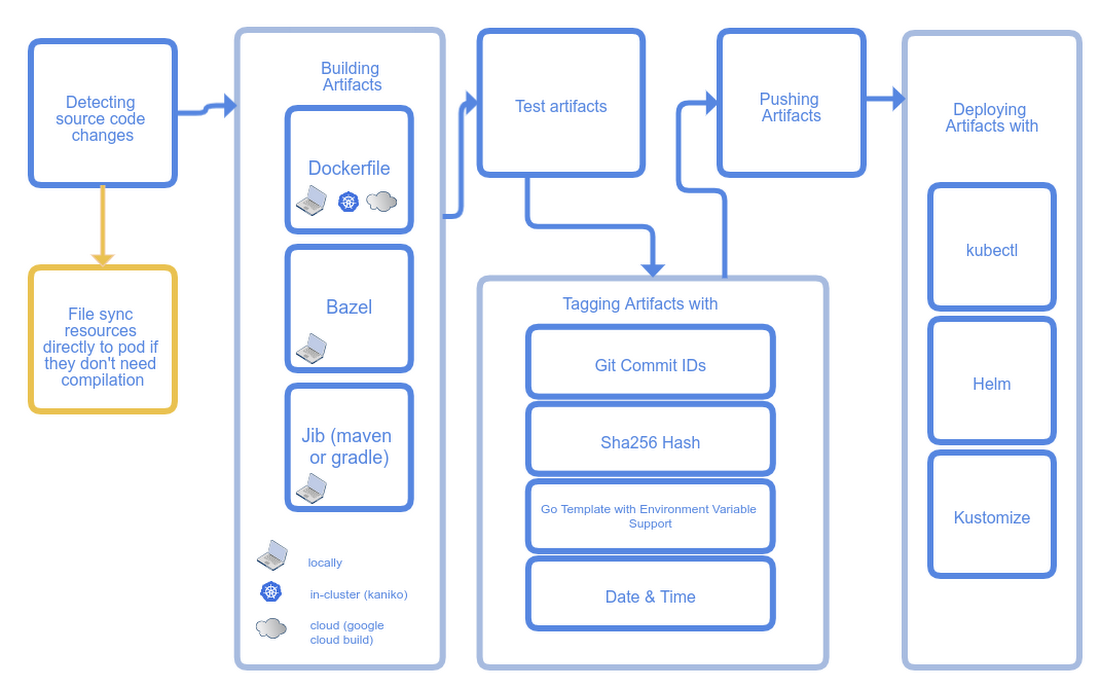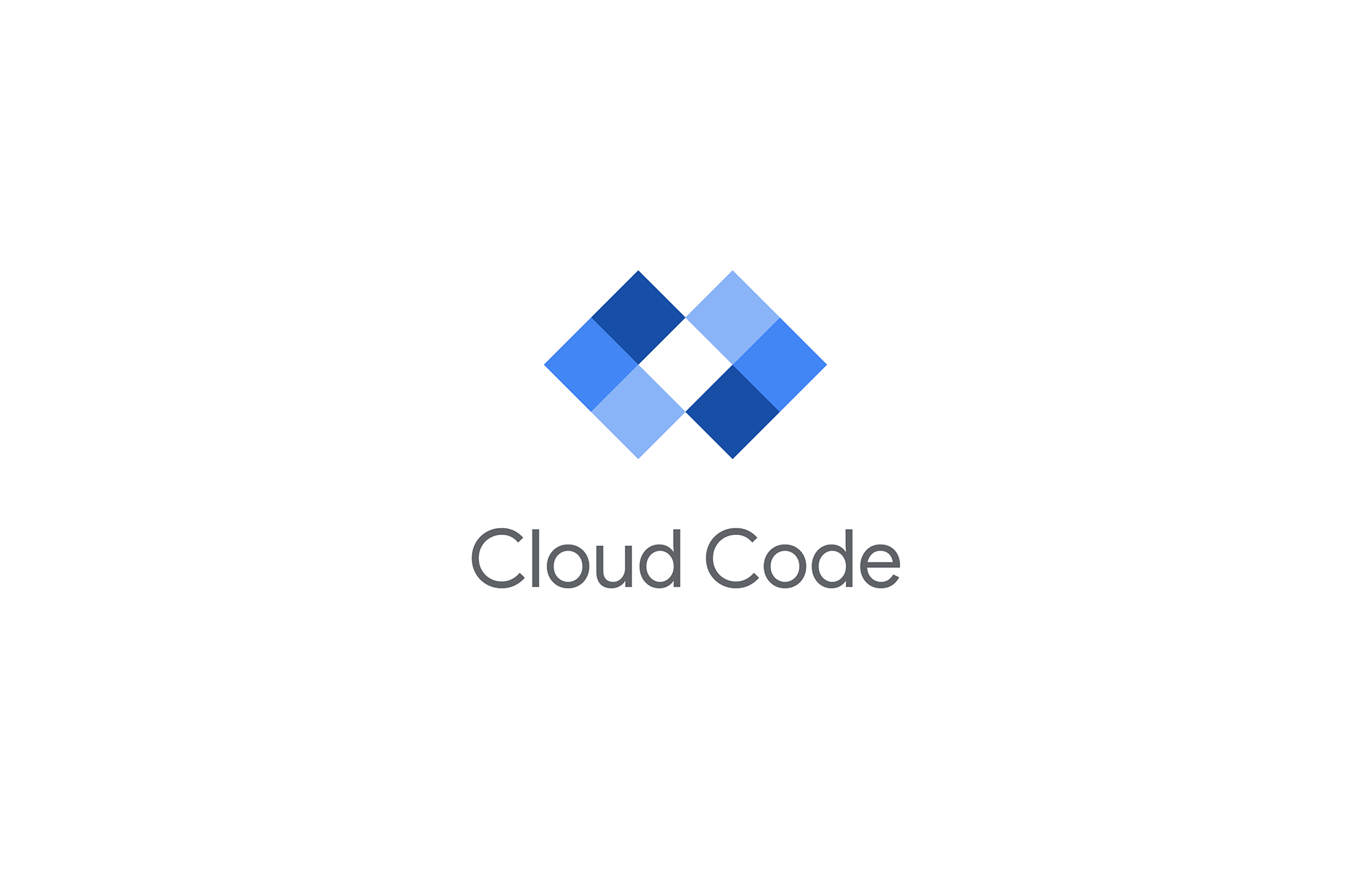Kubernetes development, simplified—Skaffold is now GA
Nick Kubala
Software Engineer
Russell Wolf
Product Manager
Back in 2017, we noticed that developers creating Kubernetes-native applications spent a long time building and managing container images across registries, manually updating their Kubernetes manifests, and redeploying their applications every time they made even the smallest code changes. We set out to create a tool to automate these tasks, helping them focus on writing and maintaining code rather than managing the repetitive steps required during the edit-debug-deploy ‘inner loop’. From this observation, Skaffold was born.
Today, we're announcing our first generally available release of Skaffold. Skaffold simplifies common operational tasks that you perform when doing Kubernetes development, letting you focus on your code changes and see them rapidly reflected on your cluster. It's the underlying engine that drives Cloud Code, and a powerful tool in and of itself for improving developer productivity.
Skaffold’s central command, skaffold dev, watches local source code for changes, and rebuilds and redeploys applications to your cluster in real time. But Skaffold has grown to be much more than just a build and deployment tool—instead, it’s become a tool to increase developer velocity and productivity.
Feedback from Skaffold users bears this out. “Our customers love [Kubernetes], but consistently gave us feedback that developing on Kubernetes was cumbersome. Skaffold hit the mark in addressing this problem,” says Warren Strange, Engineering Director at ForgeRock. “Changes to a Docker image or a configuration that previously took several minutes to deploy now take seconds. Skaffold's plugin architecture gives us the ability to deploy to Helm or Kustomize and use various Docker build plugins such as Kaniko. Skaffold replaced our bespoke collection of utilities and scripts with a streamlined tool that is easy to use.”
A Kubernetes developer's best friend
Skaffold is a command line tool that saves developers time by automating most of the development workflow from source to deployment in an extensible way. It natively supports the most common image-building and application deployment strategies, making it compatible with a wide variety of both new and pre-existing projects. Skaffold also operates completely on the client-side, with no required components on your cluster, making it super lightweight and high-performance.


By taking care of the operational tasks of iterative development, Skaffold removes a large burden from application developers and substantially improves productivity.
Over the last two years, there have been more than 5,000 commits from nearly 150 contributors to the Skaffold project, resulting in 40 releases, and we’re confident that Skaffold’s core functionality is mature. To commemorate this, let’s take a closer look at some of Skaffold’s core features.
Fast iterative development
When it comes to development, skaffold dev is your personal ops assistant: it knows about the source files that comprise your application, watches them while you work, and rebuilds and redeploys only what's necessary. Skaffold comes with highly optimized workflows for local and remote deployment, giving you the flexibility to develop against local Kubernetes clusters like Minikube or Kind, as well as any remote Kubernetes cluster.
"Skaffold is an amazing tool that simplified development and delivery for us,” says Martin Höfling, Principal Consultant at TNG Technology Consulting GmbH. “Skaffold hit our sweet spot by covering two dimensions: First, the entire development cycle from local development, integration testing to delivery. Second, Skaffold enabled us to develop independently of the platform on Linux, OSX, and Windows, with no platform-specific logic required."
Skaffold’s dev loop also automates typical developer tasks. It automatically tails logs from your deployed workloads, and port-forwards the remote application to your machine, so you can iterate directly against your service endpoints. Using Skaffold’s built-in utilities, you can do true cloud-native development, all while using a lightweight, client-side tool.
Production-ready CI/CD pipelines
Skaffold can be used as a building block for your production-level CI/CD pipelines. Taylor Barrella, Software Engineer at Quora, says that “Skaffold stood out as a tool we'd want for both development and deployment. It gives us a common entry point across applications that we can also reuse for CI/CD. Right now, all of our CI/CD pipelines for Kubernetes applications use Skaffold when building and deploying.”
Skaffold can be used to build images and deploy applications safely to production, reusing most of the same tooling that you use to run your applications locally. skaffold run runs an entire pipeline from build to deploy in one simple command, and can be decomposed into skaffold build and skaffold deploy for more fine-tuned control over the process. skaffold render can be used to build your application images, and output templated Kubernetes manifests instead of actually deploying to your cluster, making it easy to integrate with GitOps workflows.
Profiles let you use the same Skaffold configuration across multiple environments, express the differences via a Skaffold profile for each environment, and activate a specific profile using the current Kubernetes context. This means you can push images and deploy applications to completely different environments without ever having to modify the Skaffold configuration. This makes it easy for all members of a team to share the same Skaffold project configuration, while still being able to develop against their own personal development environments, and even use that same configuration to do deployments to staging and production environments.
On-cluster application debugging
Skaffold can help with a whole lot more than application deployment, not least of which is debugging. Skaffold natively supports direct debugging of Golang, NodeJS, Java, and Python code running on your cluster!
The skaffold debug command runs your application with a continuous build and deploy loop, and forwards any required debugging ports to your local machine. This allows Skaffold to automatically attach a debugger to your running application. Skaffold also takes care of any configuration changes dynamically, giving you a simple yet powerful tool for developing Kubernetes-native applications. skaffold debug powers the debugging features in Cloud Code for IntelliJ and Cloud Code for Visual Studio Code.


Cloud Code: Kubernetes development in the IDE
Cloud Code comes with tools to help you write, deploy, and debug cloud-native applications quickly and easily. It provides extensions to IDEs such as Visual Studio Code and IntelliJ to let you rapidly iterate, debug, and deploy code to Kubernetes. If that sounds similar to Skaffold, that’s because it is—Skaffold powers many of the core features that make Cloud Code so great! Things like local debugging of applications deployed to Kubernetes and continuous deployment are baked right into the Cloud Code extensions with the help of Skaffold.
To get the best IDE experience with Skaffold, try Cloud Code for Visual Studio Code or IntelliJ IDEA!
What's next?
Our goal with Skaffold and Cloud Code is to offer industry-leading tools for Kubernetes development, and since Skaffold’s inception, we’ve engaged the broader community to ensure that Skaffold evolves in line with what users want. There are some amazing ideas from external contributors that we’d love to see come to fruition, and with the Kubernetes development ecosystem still in a state of flux, we’ll prioritize features that will have the most impact on Skaffold’s usefulness and usability. We’re also working closely with the Cloud Code team to surface Skaffold’s capabilities inside your IDE.
With the move to general availability, it’s never been a better time to start using (or continue to use) Skaffold, trusting that it will provide an excellent and production-ready development experience that you can rely on.
For more detailed information and docs, check out the Skaffold webpage, and as always, you can reach out to us on Github and Slack.
Special thanks to all of our contributors (you know who you are) who helped make Skaffold the awesome tool it is today!



